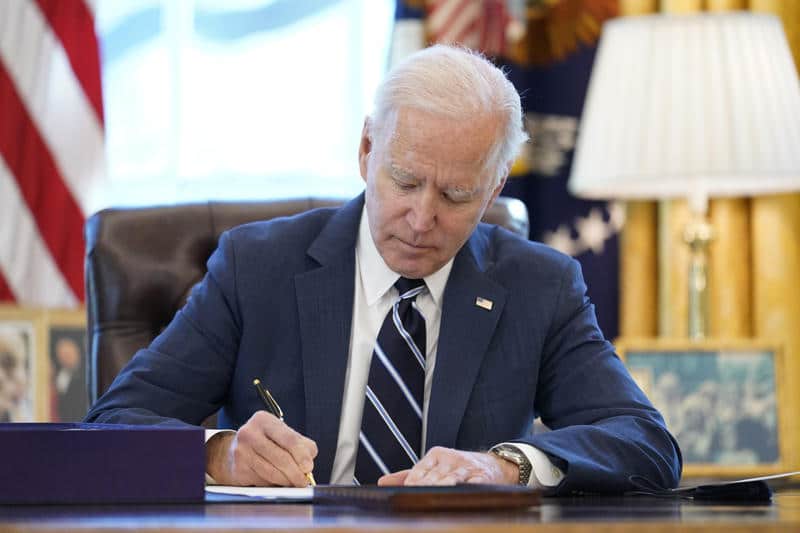The American Rescue Plan Act of 2021 (ARP or “the Act”) was signed into law by President Biden on March 11, 2021. The $1.9 trillion package follows the 2020 enactment of five bills providing nearly $4 trillion in COVID relief. The final ARP includes a few compromises from the originally proposed bill (most notably, the elimination of the minimum wage increase), but achieves many of the goals set by the Democrats in Congress ‒ including having the bill become law by March 14, 2021, when a number of provisions extended by the Consolidated Appropriations Act expire.
The legislation passed without a single Republican vote in either the House or Senate. The bill was approved narrowly in the House on March 10, 2021, by a vote of 220 to 211 (only one Democrat joined all Republicans to vote against it). It passed the Senate on March 6, 2021, with a 50 to 49 vote, also along party lines. GOP lawmakers, arguing that the package was too bloated and focused on a liberal agenda, warned that the country will pay a price for the extra spending.
A primary intention of the American Rescue Plan was to provide significant assistance for lower- and middle-income families. Many of the provisions, including stimulus checks, expanded child tax credits, extension of unemployment benefits and assistance for housing, food and utility costs, address that objective. In addition to the relief measures aimed at individuals, the package includes funds to help businesses recover, to reopen schools, to support state and local governments, and to expand COVID-19 vaccination and testing programs. The primary provisions are detailed below.
Help for Individuals
Stimulus checks
The ARP includes a third round of stimulus payments of $1,400 per eligible individual ($2,800 for married taxpayers filing jointly). These benefits begin to phase out at $75,000 adjusted gross income for single taxpayers ($150,000 for couples), and those earning over $80,000 ($160,000 for married joint filers) are not eligible for the relief checks. Dependents, including college students and qualifying adult relatives in eligible households, also qualify for the $1,400 economic impact payments. The IRS is expected to begin sending the first payments out through direct deposit by the end of March.
Though previously excluded from recovery rebates, eligible U.S. residents who are married to undocumented residents are allowed to receive stimulus relief in this round.
Child tax credits
In an effort touted to lift more than 4 million children out of poverty by providing direct aid to families on a recurring basis, the ARP expands the child tax credit for low- and middle-income families. Additionally, the expanded credit is fully refundable for 2021.
The legislation increases the credit from $2,000 to $3,000 for each child ages 6-17 ($3,600 for children younger than six). The increased credit amount phases out for single taxpayers with incomes over $75,000 ($150,000 for married taxpayers filing jointly; $112,500 for heads of household), reducing the expanded portion of the credit by $50 for each $1,000 of income over those limits.
To help low-income households and those whose earnings can fluctuate from month-to-month, starting in July 2021, the IRS will make advance payments of the estimated credit amount in order to guarantee monthly income to eligible households through December 2021. Taxpayers will be able to opt out of the advance payments or provide information relevant to modifying the amount, and will be required to reconcile the estimated advance payments with the actual credit amounts on their 2021 tax returns.
Unemployment insurance
Under the ARP, federal supplemental unemployment benefits, which were set to expire on March 14, 2021, are extended through September 6, 2021. Though originally proposed to be $400 per week, a last-minute compromise reduced them to $300.
The legislation also adds a new tax exclusion for unemployment benefits, which were taxable under the CARES Act. The ARP makes the first $10,200 in unemployment benefits tax-free in 2020 for taxpayers making less than $150,000 per year. Taxpayers who have already filed their 2020 returns and paid tax on the amount can file an amended return to claim a refund.
Additionally, the relief package extends Pandemic Unemployment Assistance to those who would not regularly qualify for unemployment insurance, including the self-employed, gig workers and freelancers. Pandemic Emergency Unemployment Compensation, available for those who exhaust state unemployment benefits, was extended from 24 to 53 weeks.
Food and housing assistance
The ARP includes $45 billion to help low-income taxpayers who have lost jobs with rent, mortgages and utility bills. An additional $5 billion is provided to states and localities to offer emergency housing for families facing homelessness.
Additionally, the legislation increases Supplemental Nutrition Assistance Program (SNAP) benefits by 15% and extends them through September 30, 2021. The relief package also provides funds to help food outlets to upgrade their systems to accept SNAP benefits online and extends Pandemic EBT, a program that sends food money to families of children who typically rely on free school meals.
Health care coverage
The legislation subsidizes COBRA continuation coverage for laid-off workers by providing a tax credit that covers 100% of the costs for a six-month period from April 1, 2021 through September 30, 2021. The ARP also expands provisions of the Affordable Care Act (ACA) to improve access and affordability and includes new incentives for states that have not yet expanded their Medicaid programs.
Help for Businesses
Small business loan programs
The ARP includes $15 billion for targeted Economic Injury Disaster Loans and an additional $7.25 billion for forgivable loans in the Paycheck Protection Program (PPP). The legislation also expands PPP loan eligibility to additional types or organizations, including more not-for-profits, labor organizations and media companies.
Industry-specific aid
The relief package includes targeted funds for industries that were hit hard by COVID-19. The ARP sets aside $28.6 billion for the hospitality industry, through the Restaurant Revitalization Fund to provide grants for restaurants who have been negatively impacted by pandemic-related restrictions and closures. Like the PPP, this program will be administered by the SBA. An additional $1.25 billion was allocated the Shuttered Venue Operators Grant (SVOG) program, which was created as part of the Consolidated Appropriations Act in December 2020. The ARP also clarified that applicants can receive both PPP and SVOG funds.
Additionally, the Act provides $14 billion for eligible airlines and $1 billion for contractors to the air carriers, to extend a payroll support program set to run out on March 31, 2021. An additional $8 billion is allocated for airports to use modify facilities or protect personnel to prevent the spread of COVID-19.
The ARP also sets aside $4 billion for Black farmers to assist with debt relief.
Employee retention credit
The Act expands the Employee Retention Credit (ERC), originally enacted in the CARES Act in March 2020, and extends it through the end of 2021 (it was previously only available for wages paid through June 30, 2021). The ERC, which allows eligible employers to claim a credit for paying qualified wages to employees, is modified by the ARP to expand eligibility to newer businesses and to allow employers to take wages paid to all employees into account when calculating the credit amount.
Credits for paid leave
Although the ARP does not require employers to offer paid leave, it does provide fully refundable tax credits to reimburse them for coronavirus-related paid sick leave and family and medical leave. The legislation codifies the credits against payroll taxes for sick and family leave originally enacted by the Families First Coronavirus Response Act and extends them to September 30, 2021. The Act also expands the credits to allow 501(c)(1) governmental organizations to take them.
Additional Targeted Aid
State and local governments
The ARP includes $360 billion in aid for state, local and territorial governments that have faced higher costs and lower tax revenue during the pandemic. The package also includes funding intended for use to improve critical infrastructure including broadband internet, and money for rural hospitals. Pennsylvania was allocated $7.3 billion and local governments will receive $6.1 billion in assistance.
Schools and childcare centers
The Act includes $170 billion to help schools re-open safely. Of that amount, $130 billion is earmarked for K-12 schools to help them hire additional staff to reduce class size, modify spaces and provide needed resources. The remaining $40 billion is directed to colleges and universities. In an effort to expedite the return of students, schools receiving funds are required to submit plans within 30 days about how they plan to re-open.
The ARP also provides $25 billion to open childcare centers and an additional $15 billion in grants to help essential workers with childcare costs.
Vaccinations and testing
The legislation includes $160 billion for improving vaccine and testing programs. The ARP includes money for national vaccine distribution to provide free shots to all U.S. residents; funding to create community vaccination centers and deploy mobile units in hard-to-reach areas; and additional resources directed toward improving testing efforts.
Final Thoughts
Now that this relief package has been signed into law, attention will turn to the various government agencies charged with administering the new programs to release additional guidance. Lawmakers will shift their focus to a longer-term economic recovery plan. The next major bill in the works is expected to be aimed at job creation, infrastructure investment and development goals such as climate change.
Taxpayers are encouraged to contact their GYF Executive at 412-338-9300 with any questions about the new provisions, and to discuss whether amended returns or grant/loan applications are needed to take advantage of the benefits.






